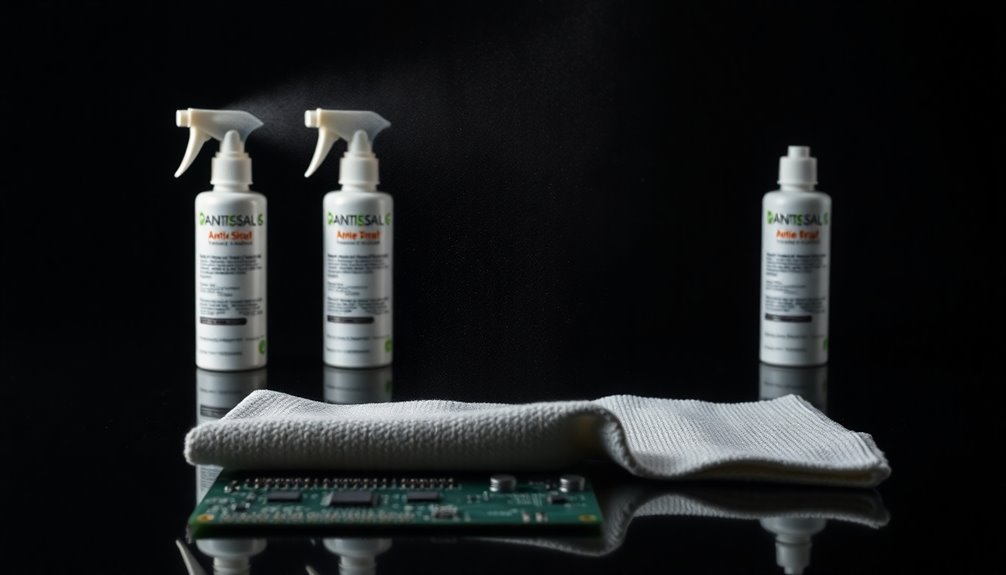For electronics maintenance, you'll find excellent protection with Techspray's Zero Charge Anti-Stat Coating, which covers up to 2.5 square meters and meets strict ANSI/ESD standards. Sprayway's Anti-Static Spray offers a budget-friendly option at around $3.99, proving particularly effective on various surfaces while remaining safe for sensitive components. Techspray's Licron Crystal ESD-Safe Coating rounds out the top three with its specialized formulation for maximum static control. When choosing between these options, you'll want to take into account factors like surface compatibility, coverage needs, and your specific protection requirements to make the best selection for your equipment.
Top Antistatic Spray Products

Among the leading antistatic spray products, Techspray and Sprayway stand out as trusted manufacturers in electronics maintenance.
Techspray's ESD products offer impressive coverage, with their aerosol formula protecting up to 2.5 square meters with just two light coats. If you're working on larger projects, their bulk solution covers approximately 972 square feet per gallon. These sprays are especially crucial during winter months, when static electricity builds up more readily due to dry air.
Sprayway's Anti-Static Spray provides versatile protection at an affordable price point of around $3.99. You'll find it's safe to use on various materials, including clothes, carpets, rugs, and drapes, while leaving no residue behind. It's particularly effective on synthetic fabrics, where static buildup is most common.
You can also consider popular alternatives like Endust and Pledge, which users frequently mention in forums for their effectiveness. These products form an invisible protective layer against electrostatic discharge while being gentle on your electronics.
When choosing an antistatic spray, you'll want to verify it's specifically designed for your intended application. Most options provide all-day protection and work exceptionally well in dry environments where static electricity poses the greatest risk to your electronic equipment.
Protecting Electronics With Antistatic Solutions
While antistatic sprays offer immediate protection, a thorough approach to electronics protection requires multiple layers of defense. You'll need to combine various antistatic solutions to create a thorough shield against static electricity damage. Regular ESD damage assessment helps identify vulnerabilities in your protection strategy and prevents costly component failures.
Start by setting up your workspace with an ESD mat and always wear a grounding wrist strap when handling sensitive components.
For storing and transporting electronics, you'll want to use static shielding bags rather than basic anti-static bags. These bags create a Faraday cage effect, protecting your components from both internal and external static charges. Their surface resistivity of 10^4 to 10^6 ohms/square guarantees proper charge dissipation.
Don't forget to maintain proper humidity levels in your workspace, and consider using ionizing air blowers in dry environments. When handling circuit boards or semiconductor devices, you'll need packaging with conductive materials (carbon-loaded plastics or metalized films) that can effectively dissipate charges.
Remember that tribocharging from friction poses a significant risk, so choose materials specifically designed to prevent this effect. For long-term storage, opt for static shielding boxes or containers that provide complete protection against ESD damage.
Choosing The Right Antistatic Spray

Selecting the right antistatic spray requires careful consideration of several key factors. You'll need to match the spray type to your specific application, whether you're protecting sensitive electronics, treating fabric surfaces, or maintaining industrial equipment.
For electronic devices, choose specialized sprays containing silicone compounds that offer enhanced protection against moisture and dust. These formulations feature ultra-low particle sizes that effectively neutralize static charges while providing long-lasting protection for your equipment. The thin invisible layer formed on surfaces helps prevent triboelectric charging during material contact.
When working with general surfaces like carpets or furniture, you can opt for general-purpose sprays with mild surfactants.
Before making your selection, consider the coverage area you'll need to treat. A one-liter bottle typically covers about 20 square meters, so calculate accordingly.
You'll also want to check the spray's safety features – look for non-toxic, non-staining formulas that won't damage your surfaces or equipment.
If you're dealing with professional environments, consider liquid sprays that allow for specific dilutions on hard surfaces. Alternatively, if you need a quick solution for occasional use, aerosol sprays provide convenient application through their propellant-driven fine mist delivery system.
Frequently Asked Questions
Can Antistatic Sprays Damage Touchscreen Displays?
Yes, antistatic sprays can damage your touchscreen if they contain harsh chemicals like alcohol or ammonia. You'll want to use only electronics-specific cleaners and apply them to a microfiber cloth, not directly on screens.
How Long Does Antistatic Spray Protection Typically Last in Humid Conditions?
In humid conditions above 55%RH, you'll find your antistatic spray protection lasts longer, typically 5-6 months. You won't need to reapply as frequently since humidity naturally helps prevent static buildup.
Should Antistatic Sprays Be Reapplied After Cleaning Electronics With Other Solutions?
Yes, you'll need to reapply antistatic spray after using other cleaning solutions, as they can strip away the protective coating. It's best to wait until the surface is completely dry before reapplication.
Are Antistatic Sprays Safe to Use on Vintage Electronic Equipment?
You'll want to use non-flammable, alcohol-free antistatic sprays on vintage electronics. Make sure to choose formulations specifically designed for older equipment to prevent damage to delicate components and sensitive materials.
Do Antistatic Sprays Affect the Color or Appearance of Plastic Components?
No, you won't notice any color changes when using antistatic sprays. They'll leave a streak-free finish and won't damage your plastic components. The sprays are non-abrasive and preserve the original appearance.
In Summary
By selecting any of these three antistatic sprays, you'll effectively protect your electronic devices from static electricity damage. Remember to take into account your specific needs, application frequency, and budget when making your choice. Whether you're maintaining professional equipment or personal devices, proper antistatic protection isn't optional – it's essential for extending the life of your valuable electronics and preventing costly repairs.





Leave a Reply